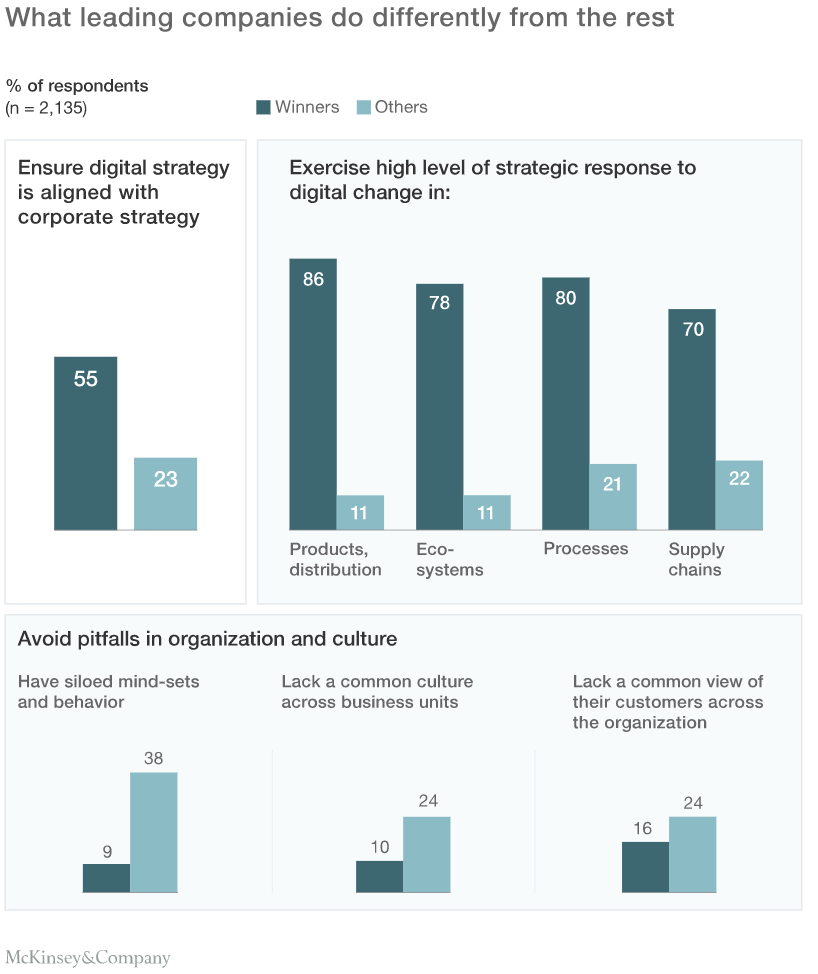Over the last five months, COVID-19 has dramatically changed the way customers shop, placing an increasing dependency on digital technology. With brick-and-mortar closures and customers transitioning to only buying online, ecommerce retailers’ traffic has increased by nearly 2 billion in just a few months.
Now, more than ever it's critical companies build an infrastructure that helps them respond nimbly to customer needs on all platforms and devices. Let's take a look at why and how ecommerce companies are turning to digital transformation to achieve this agility and inspire growth.
What is Digital Transformation?

Digital transformation is a strategy that reimagines a company's core business using technology to maximize opportunities. With 4.6 billion internet users worldwide, companies using old business models risk losing sales due to the ease of customers clicking to a competitor. Peter Drucker, often described as the inventor of management, once wrote, "The greatest danger in times of turbulence is not the turbulence — it's to act with yesterday's logic."
While technology can make things faster and more efficient, digital transformation, as it relates to ecommerce, involves merging technologies with a thorough analysis of procedures across operations and departments to help improve the customer experience.
Not only does this provide more flexibility in responding to changing customer behavior, but it ensures enterprises are ready to take full advantage of future markets and opportunities created by digitization. The majority of leading companies integrate their digital and corporate strategies and invest more widely in technology, according to a McKinsey study.

Elements of Digital Transformation

A true digital transformation requires a top-to-bottom rethink of how a company's business model can improve outcomes in a customer-centric environment. There are many elements to this process, but here are three priorities to consider:
1. Adopting digital technologies.
McKinsey compared organizations with successful digital transformations and found that those that embrace technology are more likely to report improved and sustained performance over time.
A wide range of innovations are available to improve efficiency, reduce costs, and maximize revenue, and companies must consider which technologies add value to their core business. Inventory management software, artificial intelligence tools, and cloud-based technologies, such as IaaS, PaaS, and SaaS, can all optimize workflows and processes.
Jeep people, a B2B automotive parts seller, adopted new technology to upgrade a complex discounting system that required manual ordering and invoicing in order to tailor pricing for different customers. Using an agile ecommerce platform, wholesalers and dealers now log into the store, access custom prices, and complete purchases instantly. The company tripled its revenue within a year.
2. Better customer experience.
One of the reasons for digital transformation is to improve customer experience in an increasingly competitive ecommerce landscape. This includes removing friction in the business model and using data to respond to buying patterns and behavior. Delivering personalized experiences and anticipating customer needs can develop brand loyalty and differentiate a company from a competitor.
As enterprises realize the importance of customer experience, spending on CX technologies by B2B and B2C companies is expected to grow by a CAGR of 8.2% over five years, reaching $641 billion in 2022, according to IDC. The retail industry should spend the most during this period, investing $56.7 billion in digital marketing, AI-driven engagement, and order fulfillment.
3. Modernizing company culture.
Digital transformation is a new mindset and requires the whole company to be on board, with buy-in from management and employees through all functions, such as:
- Introducing internal, interactive communication channels.
- Supporting continuing learning.
- Empowering employees to take calculated risks.
- Encouraging new ways of doing things.
- Introducing open work environments and collaboration.
James Bilefield, a digital entrepreneur, suggests cultural change might be the hardest part of digital transformation, especially companies that have a strong legacy and haven't changed for decades. Transformation needs to involve employee input, and companies that encourage a dialogue about how to digitize operations are 1.4 times more likely to have a successful digital transformation.
Ecommerce Customers are Pushing for a Digital Adoption

As a result of COVID-19 an increasing number of consumers are opting to shop digitally. Ecommerce sales in the U.S. is now projected to grow by 27% by 2024, reaching beyond 470 million dollars.
By 2021, mobile sales should account for 54% of online sales, making it essential for an ecommerce platform to work across devices and platforms.
Customers also have diverse options once online. They buy on brand websites, retail websites, third-party marketplaces, native apps, and social media. They also shop in physical stores and pop-ups. Businesses of all sizes must develop a strategy to increase customer engagement, wherever customers are interacting.
Omnichannel commerce brings multiple channels together by integrating digital and physical channels into a single, uninterrupted experience. Skullcandy, for example, is finding customers on social media with distributed ecommerce and enabling them to purchase natively without shifting to the retail website.
Through an agile ecommerce platform, social media orders flow directly to the Skullcandy store for streamlined fulfillment, removing friction from the buying experience. As customers become accustomed to a variety of platforms and devices, they want the organizations they work with to deliver a reliable quality of service. Businesses must ensure all channels are available and connected.
Digital Transformation Driving New Ecommerce Technologies

Digital transformation is an expansive undertaking that touches all aspects of a company's operations. Still, most companies are focusing digitization efforts on marketing and distribution because of where customers interact with the company. Businesses may be overlooking emerging opportunities for growth in other functions.
Here's a closer look at how strategies such as automation, artificial intelligence, and end-to-end analytics can enhance customer experience and drive sales through an ecommerce platform.
1. Automation.
Automation of basic processes can speed up the workflow and eliminate the chance of error. For example, companies can keep products stocked and prevent overselling by syncing data across orders, inventory, and purchasing. Technology can remove out-of-stock items from a website, track unusual activity on high-risk orders, and schedule online sales and promotions. Customer communication can be automated to advise when orders are received or shipped.
As productivity increases through automation, employee resources can be redirected to building relationships, collecting leads, and business development.
2. Artificial intelligence and machine learning.
Ecommerce platforms have access to an enormous amount of data about customer behavior. Artificial intelligence and machine learning use the data to help businesses anticipate customer needs and make better decisions. This technology could boost profitability rates by 59% in the wholesale and retail industries by 2035, according to Accenture.
Predictive product recommendations
Machine learning can analyze a single customer's behavior through multiple channels based on what they've purchased or browsed. Customers are served personalized search results and smart product recommendations, saving them browsing time, ensuring they see the most relevant products.
Predictive behavior modeling
AI can also identify segments of customers and build models that predict group behavior. By understanding a specific group of customers, companies can predict overall behavior and decide if a marketing campaign will work for that target audience. They can also gain insight into targeting similar customers.
Dynamic pricing
Pricing has always been affected by supply and demand, but today's digital world is accelerating the need for up-to-date information. AI can track and detect patterns based on real transactions, customer behavior, and competitor activity to find the optimal price for a product. Amazon uses this technology to determine when to discount certain items and the highest price that still converts customers.
3. End-to-end analytics.
With data available from all stages of a purchasing journey, companies can use end-to-end analytics to gain insight into how a customer interacts with a brand. This data guides decisions about the kind of personalized offers, ads, and messages a customer should receive as they progress through the sales funnel.
4. Headless commerce.
Headless commerce gives businesses the flexibility to seamlessly sell through multiple channels and respond to consumer preferences. While traditional ecommerce platforms are monoliths with the frontends and backends connected, a headless strategy decouples these components so other platforms can be effortlessly integrated.
Personalization
Headless commerce makes it easier to implement omnichannel marketing by bringing together all of the channels customers use to interact with a business. Product and customer information in the backend of an ecommerce platform can be called through APIs and funneled to multiple devices and platforms.
Consumers receive the same consistent information whether they're on a mobile app, website, or speaking to a customer care representative. This enables companies to extract data and personalize experiences for seamless integration of all channels, enriching the customer experience.
Flexibility
Headless commerce empowers companies to link multiple platforms and devices to their backend, allowing greater flexibility in the type of content delivered to consumers. New channels can be set up much more quickly than with traditional commerce.
LARQ, for example, uses a headless commerce model that pulls product information from a central location to five regional sites on the frontend. All of the stores are accessed through a single domain, with each regional site customized for languages, currencies, and payments, for an easy and efficient workflow. As the brand grows, additional channels can be easily added.
5. Customer experience marketing.
Customer experience marketing focuses on engaging a customer through all stages and channels of the purchasing journey. Here are examples of how technology can improve conversion.
Connect the customer to the right product
Customers respond to personalization, whether it's product recommendations based on buying patterns or retargeting emails that remind them of an abandoned cart. Use data to understand your customer and deliver relevant, useful information.
Facilitate decision-making
Online reviews and video testimonials provide social proof to demonstrate that a brand is trustworthy. Product demos on social media, 3D product imaging using digital twin technology, augmented reality, and virtual reality can help customers visualize how a product might improve their lives. Chatbots help to keep a customer in the sales funnel by answering questions instantly. Cost of Income rounded up some of the best chatbot builders that you can use immediately.
Optimize omnichannel and customer care
Whether a customer is on a website, retail app, social media, or in-store, they should be able to interact seamlessly with your company. Each channel must be optimized for an effortless checkout, and all transaction information should link to a single customer account history.
Executive Summary
As digital shoppers engage with businesses on multiple channels, companies must respond with a superior customer experience to stay competitive. Digital transformation helps businesses to improve customer relationships across all devices and platforms. This can involve several strategies, such as headless commerce, automation, AI and machine learning, social commerce, augmented reality, and end-to-end analytics.
Companies that integrate these digital technologies with customer-centric corporate strategies are ideally positioned to spark the growth of their ecommerce enterprise.

-
You’ll read about:
Be the first to know
Subscribe to our newsletter








